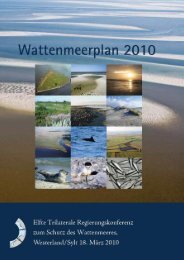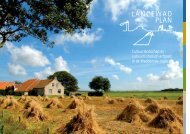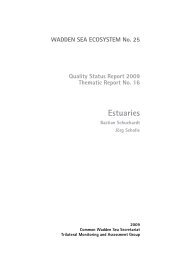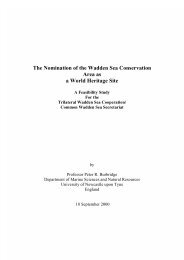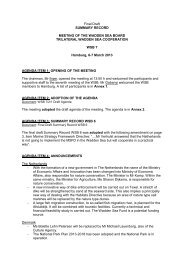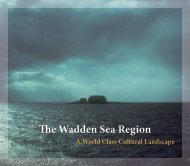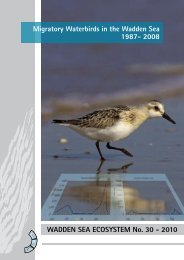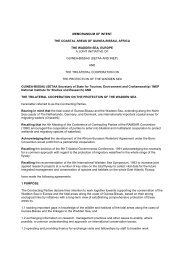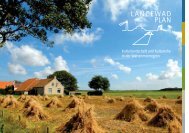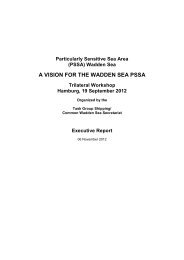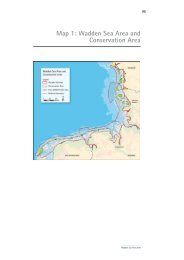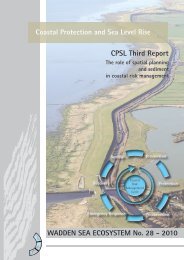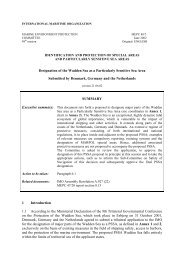Steve Coates, Environmental Agency, London, UK: WFD transitional
Steve Coates, Environmental Agency, London, UK: WFD transitional
Steve Coates, Environmental Agency, London, UK: WFD transitional
You also want an ePaper? Increase the reach of your titles
YUMPU automatically turns print PDFs into web optimized ePapers that Google loves.
Water Framework Directive<br />
Transitional Fish Classification<br />
Scheme<br />
<strong>Steve</strong> <strong>Coates</strong>, Alice Anwar,<br />
<strong>Steve</strong> Colclough, Matt Robson<br />
& Trevor Harrison.
Water Framework Directive<br />
g 22nd Dec 2000 - Directive of EU Parliament<br />
g Requires EU Member States to:<br />
g develop monitoring programmes<br />
g develop estuarine classification systems<br />
g achieve good ecological status of surface<br />
waters by 2015
<strong>WFD</strong> Timeline<br />
Develop<br />
classification<br />
& monitoring<br />
schemes<br />
Trial<br />
classification<br />
schemes<br />
Intercalibration<br />
Complete<br />
Intercalibration<br />
Start<br />
monitoring Continue<br />
monitoring<br />
Draft RBMPs<br />
Complete<br />
monitoring<br />
Final RBMPs<br />
Review characterisation<br />
and monitoring programmes<br />
All waters at<br />
‘Good Status’<br />
2004 2005 2006 2007 2008 2009 ……... ……...<br />
2015
Biological Quality Elements<br />
Phytoplankton<br />
Macroalgae<br />
Biological<br />
Quality<br />
Fish<br />
Angiosperms<br />
Benthic<br />
Invertebrates
<strong>UK</strong> <strong>WFD</strong> Biological Task Teams<br />
MPMMG / NMMP<br />
Marine Plants Task<br />
Team<br />
<strong>WFD</strong> Implementation<br />
Steering Group<br />
Technical Advisory<br />
Group (TAG)<br />
Marine Task Team<br />
(MTT)<br />
Marine Fish Task<br />
Team<br />
Inter-<strong>Agency</strong> Maritime<br />
Group<br />
Marine Benthic<br />
Invertebrate Task<br />
Team
Surface Water<br />
Objectives<br />
Physicochemical+<br />
Quality<br />
Standards<br />
No or {<br />
very<br />
minor<br />
Slight{<br />
Moderate{<br />
Major{<br />
Severe{<br />
ECOLOGICAL<br />
STATUS<br />
HIGH<br />
GOOD<br />
MODERATE<br />
POOR<br />
BAD<br />
Prevent<br />
deterioration<br />
Restore
Normative Definitions of Transitional Waters - Fish<br />
Element High Ecological<br />
Status<br />
Fish Species<br />
fauna composition<br />
and abundance<br />
is consistent<br />
with<br />
undisturbed<br />
conditions<br />
Good Ecological<br />
Status<br />
The abundance of<br />
the disturbancesensitive<br />
species<br />
shows slight signs of<br />
distortion from the<br />
type-specific<br />
conditions<br />
attributable to<br />
anthropogenic<br />
impacts on<br />
physiochemical or<br />
hydromorphological<br />
quality elements<br />
Moderate Ecological<br />
Status<br />
A moderate<br />
proportion of the<br />
type-specific<br />
disturbance-sensitive<br />
species are absent as<br />
a result of<br />
anthropogenic<br />
impacts on the<br />
physiochemical or<br />
hydromorphological<br />
quality elements
What are the disturbance<br />
sensitive species?<br />
g Most fish considered to be disturbance sensitive<br />
g Some more sensitive than others e.g. to poor<br />
water quality<br />
g Diadromous species particularly sensitive:<br />
g Either have life cycles associated with TW’s or<br />
fry which penetrate into freshwaters
Smelt -<br />
Osmerus<br />
eperlanus<br />
Sea trout -<br />
Salmo trutta
Fish Survey Design<br />
g Estuarine fish depend upon a range of habitats<br />
g Survey design has to reflect the inherent temporal<br />
& spatial variability within a TW<br />
g Bi-annual, multi-method sampling regime has<br />
been used to assess and monitor fish communities<br />
g Standardise gear and sampling effort
Seine netting<br />
Seine netting<br />
Beam trawling
Otter trawling<br />
Otter trawling<br />
Kick sampling
Power Station Monitoring<br />
How to analyse data?
Data<br />
g Currently hold data from:<br />
g 45 <strong>transitional</strong> water bodies<br />
g 406 stations<br />
g 8800 samples<br />
g Sites vary from freshwater to marine & therefore<br />
have complex interpretation of the data<br />
g Historic <strong>UK</strong> monitoring has concentrated on<br />
impacted ‘industrialised estuaries’<br />
g Spent the past 3 years on sampling reference<br />
estuaries
Database & Analysis<br />
g Unicorn V4 has been developed for <strong>WFD</strong> to include <strong>UK</strong><br />
& ROI Transitional fish species and used in association<br />
with PRIMER multi-variate software - why multi-variate?<br />
g Univariate analysis describes association &<br />
relationships between individual variables<br />
g Multi-variate analysis examines the complex interrelationship<br />
between many variables simultaneously<br />
g Data derived from a whole range of sampling regimes,<br />
monitoring techniques and therefore varying CPUE<br />
g Further analysis of species lists with Typology and Eco-<br />
Regions - ‘Biogeographic’ problem?!
MDS ordination of fish taxa reported in<br />
European estuaries; systems are<br />
labelled according to latitude.<br />
Messolonghi<br />
NW Aland<br />
Loch Etive<br />
Gota<br />
Gullmarsfjord<br />
Darss-Zingster Oderhaff/Stettin<br />
Ems-Dollard<br />
Weser & Elbe<br />
Westerschelde<br />
Oosterschelde<br />
Forth<br />
Mersey<br />
Humber<br />
Thames<br />
Tagus<br />
Mira Ria de Aveiro<br />
Obidos<br />
Bay of Cadiz<br />
Loire<br />
Guadalquivir<br />
Ebro<br />
Stress: 0.08<br />
55-60<br />
50-55<br />
45-50<br />
40-45<br />
35-40
TW Fish Community Metrics<br />
Species diversity and composition<br />
1) ‘Species composition’<br />
2) Presence of ‘Indicator Species’<br />
Species abundance<br />
3) Species relative ‘abundance’<br />
4) Number of taxa that make up 90% of the ‘abundance’<br />
Nursery function<br />
5) Number of estuarine resident taxa<br />
6) Number of estuarine-dependent marine taxa<br />
Trophic integrity<br />
7) Functional Guild Composition<br />
8) Number of benthic invertebrate feeding taxa<br />
9) Number of piscivorous taxa<br />
10) Feeding Guild Composition
Scoring System<br />
g Based on Karr methodology (Assessment of biotic<br />
integrity using fish communities, 1981)<br />
g Score 5 - deviate slightly from reference<br />
g Score 3 - deviate somewhat from reference<br />
g Score 1 - deviate strongly from reference<br />
g Modified (similar to FAME) and Belgium<br />
classification scheme (Jan Breine and Peter<br />
Goethals et al ., 2005) -<br />
Scored now on a 5, 4, 3, 2, 1 scale
Relative Score<br />
g Scores of all 10 metrics combined<br />
g ‘Relative Score’ calculated for each sample<br />
using the following formula:<br />
RS = (Total score – minimum score possible)<br />
Maximum score possible<br />
RS ranges between 0 - 1
TW Fish Task Team Interpretation of General & Fish<br />
Structure & relevance High Status Good Status Moderate Status<br />
‘Species Composition &<br />
abundance’ – there is a high<br />
degree of taxonomic breadth<br />
present. Species richness i.e.<br />
number of taxa is not a useful<br />
measure as this is often<br />
dependant upon sampling<br />
effort.<br />
Functional Guilds describe the<br />
interaction and function of the<br />
fish faunal assemblage within<br />
an estuary. Each species is<br />
allocated a functional category<br />
CA = diadromous species<br />
FW = freshwater species<br />
ER = estuarine residents<br />
MA = marine adventitious<br />
MJ = marine juveniles<br />
MS = marine seasonal<br />
Structural changes within the<br />
community structure are<br />
associated with seasonal<br />
patterns.<br />
Species<br />
composition &<br />
abundance is<br />
consistent with<br />
undisturbed<br />
conditions.<br />
Also key life<br />
stages of<br />
‘disturbance<br />
sensitive<br />
species’ are<br />
present.<br />
Successful<br />
migration<br />
within and<br />
through the<br />
<strong>transitional</strong><br />
water<br />
associated with<br />
patterns of<br />
migration<br />
consistent with<br />
undisturbed<br />
conditions.<br />
The abundance of the<br />
disturbance sensitive<br />
species shows slight<br />
signs of distortion<br />
from type specific<br />
conditions attributable<br />
to anthropogenic<br />
impacts on physicochemical<br />
or<br />
hydomorphological<br />
quality elements.<br />
Distortion of<br />
disturbance sensitive<br />
sp. & key life stages.<br />
May be in terms of age<br />
structure as well as<br />
presence.<br />
Some disruption to<br />
migration patterns<br />
within & through the<br />
<strong>transitional</strong> water.<br />
One or more sp within<br />
a guild may be absent<br />
A moderate<br />
proportion of the typespecificdisturbancesensitive<br />
sp. are<br />
absent as a result of<br />
anthropogenic<br />
impacts on the<br />
physiochemical or<br />
hydromorph quality<br />
elements<br />
Removal/absence of<br />
disturbance sensitive<br />
sp. Including<br />
disruption of key life<br />
stages.<br />
Major disruption to<br />
migration patterns<br />
within & through the<br />
trans water.<br />
Functional Guilds<br />
absent in relation to<br />
reference conditions.<br />
Non-native fish may<br />
be present.
Seine netting
EQR’s & Boundary Criteria
Tees Analysis<br />
g Tees beam trawl data set (1982 - 2000) analysed at<br />
sample level (i.e. each sampling occasion)<br />
g Data compared against reference of beam trawl<br />
programmes within E4T2:<br />
g Blyth, Tyne, Wear & Tees<br />
g Mean annual RS calculated and compared with<br />
DO measurements<br />
g Non-reach based assessment
Tees Mean Annual RS’s<br />
RS<br />
0.6<br />
0.5<br />
0.4<br />
0.3<br />
0.2<br />
0.1<br />
0<br />
Mean RS<br />
Mean Annual DO (mg/l)<br />
Max DO (mg/l)<br />
Min DO (mg/l)<br />
19811982198319841985198619871988198919901991199219931994199519961997199819992000<br />
Year<br />
18<br />
16<br />
14<br />
12<br />
10<br />
8<br />
6<br />
4<br />
2<br />
0<br />
DO(mg/l)
Thames Analysis<br />
g Based on data from Thames, Anglian and Southern<br />
Region - Eco 4 TW3<br />
g Developed ‘method-specific’ references for multimethod<br />
techniques to reduce effects of sampling<br />
g References calculated for each metric - based on<br />
upper quintile<br />
g ‘RS’ calculated for each sampling occasion to<br />
reduce different CPUE<br />
g Used each annual sampling occasion RS to<br />
calculate a mean annual RS
RS<br />
1.00<br />
0.90<br />
0.80<br />
0.70<br />
0.60<br />
0.50<br />
0.40<br />
0.30<br />
0.20<br />
0.10<br />
0.00<br />
Upper Thames - Mean annual RS’s<br />
92 93 94 95 96 97 98 99 00 01 02 03 04<br />
Year<br />
Beam<br />
Seine<br />
B & S Mean
RS<br />
1<br />
0.9<br />
0.8<br />
0.7<br />
0.6<br />
0.5<br />
0.4<br />
0.3<br />
0.2<br />
0.1<br />
0<br />
Mid Thames - Mean annual RS’s<br />
92 93 94 95 96 97 98 99 00 01 02 03 04<br />
Year<br />
Beam<br />
Seine<br />
Otter<br />
Mean (B, S & O)
RS<br />
1<br />
0.9<br />
0.8<br />
0.7<br />
0.6<br />
0.5<br />
0.4<br />
0.3<br />
0.2<br />
0.1<br />
0<br />
Lower Thames - Mean annual RS’s<br />
Beam<br />
Seine<br />
Otter<br />
Mean (B, S & O)<br />
92 93 94 95 96 97 98<br />
Year<br />
99 00 01 02 03 04
Conclusions<br />
g Reach based assessment necessary in larger TW’s<br />
as water-bodies will be delineated in relation to<br />
pressures etc.<br />
g Method-specific references essential but require<br />
further analysis e.g:<br />
g Multi-method reference suitable for Thames<br />
g Beam trawl programme provides useful reference<br />
for Tees – however excludes certain species<br />
(sea trout), as shown by seine net catches
Current Work<br />
g Further testing and evaluation of metrics and<br />
boundary criteria<br />
g Re-development of reference conditions to<br />
incorporate ‘expert judgement’<br />
g Association of relative scores with significant<br />
pressures e.g. DO, temperature<br />
g Analyses of differences between sample level and<br />
annual level analysis<br />
g Working with EU NEAGIG Fish colleagues & Paul<br />
Quataert (Belgium) ‘European Index’ for <strong>WFD</strong>
I never dreamed that<br />
<strong>WFD</strong> monitoring<br />
could be so exciting
General Normative Definitions of Ecological status<br />
Element High Status Good Status Moderate Status<br />
General<br />
There are no, or only very<br />
minor, anthropogenic<br />
alterations to the values of<br />
the physico-chemical and<br />
hydromorphological quality<br />
elements for the surface<br />
water body type from those<br />
normally associated with<br />
that type under undisturbed<br />
conditions.<br />
The values of the biological<br />
quality elements for the<br />
surface water body reflect<br />
those normally associated<br />
with<br />
that type under undisturbed<br />
conditions, and show no, or<br />
only very minor, evidence of<br />
distortion.<br />
These are the type-specific<br />
conditions and communities.<br />
The values of the<br />
biological quality<br />
elements for the<br />
surface water body<br />
type show low levels<br />
of distortion<br />
resulting from human<br />
activity, but deviate<br />
only slightly<br />
from those normally<br />
associated with the<br />
surface water<br />
body type under<br />
undisturbed<br />
conditions.<br />
The values of the<br />
biological quality<br />
elements for the<br />
surface water body<br />
type deviate<br />
moderately from<br />
those<br />
normally associated<br />
with the surface<br />
water body type<br />
under undisturbed<br />
conditions. The<br />
values show<br />
moderate<br />
signs of distortion<br />
resulting from human<br />
activity and are<br />
significantly more<br />
disturbed than under<br />
conditions of good<br />
status.



